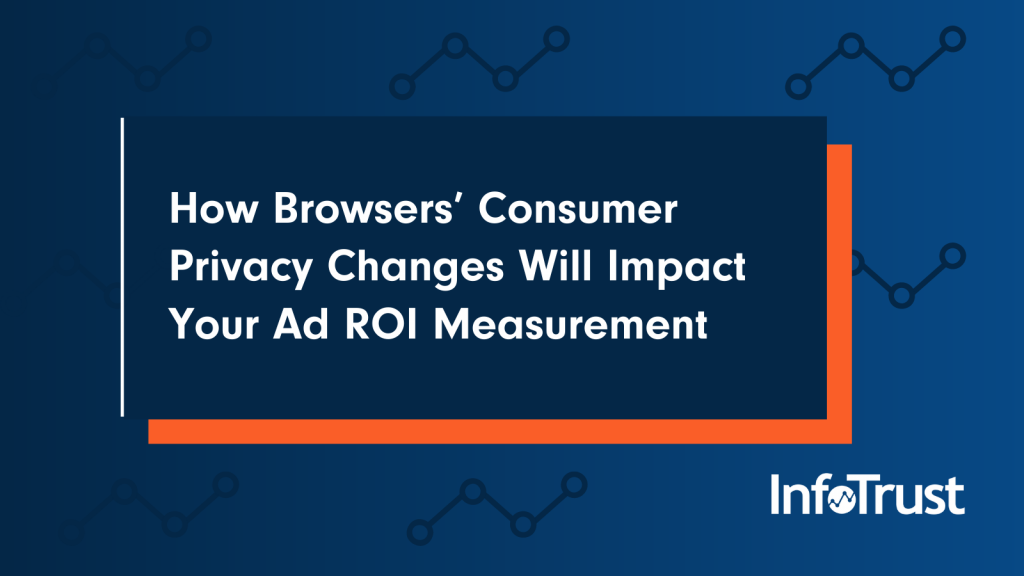Recently, Google Ad Manager ran an experiment where it disabled access to cookies for a small fraction of users to see whether ad revenues would fall when cookies were not available. They found that ad revenues fell by a whopping 52 percent for the top 500 global publishers, with a median decline of 64.5 percent per publisher.
This research makes it clear that any changes browsers make to their privacy policies will have a significant impact on advertisers. Given that all the top browsers are currently implementing these kinds of changes, business owners can’t delay grappling with the effects coming to the industry. No matter which browser you use and how lenient it may be for advertisers, the paradigm is shifting.
Below, I offer a concise summary of the upcoming changes that are taking place across 5 browsers and explain what those changes mean for marketers who are worried about the effects these upcoming changes will have on advertising and data collection. It’s important to emphasize, though, many details of these changes have not been released to the public, and there’s no definitive answer about how these changes will impact advertising and analytics. Nevertheless, it’s imperative that we pay attention to what’s on the horizon.
Google Chrome
In many ways, introducing privacy initiatives runs counter to Chrome’s ad business. About 83% of Google’s revenue in the second quarter, around $33 billion, was generated from advertising, so the company has a great incentive to implement targeted ads.
Nevertheless, in 2019, Google proposed a “privacy sandbox” that would restrict tracking technology and “create a thriving web ecosystem that is respectful of users and private by default.” In short, Google proposes to allow ads that target users’ interests, but that do not infringe upon their privacy rights. The idea is to block all third-party cookies so that a consumer’s information cannot be widely shared.
Google has proposed three ad-targeting options for Chrome’s Privacy Sandbox. The first method involves contextual and first-party data targeting. With this method, users will be shown ads that match the context of the page they’re visiting. Sandbox is responsible for informing platforms about the context of the page, rather than this being the responsibility of the platform itself.
The second method involves interest-based targeting, where users are added to groups based on the websites they visit. Advertisers can then target them based on the groups they belong to, rather than on an individual level.
The final method involves remarketing and retargeting. In one of the initial proposals, the browser will send two ad requests to the platform—one containing contextual information, while the other references the user’s interest groups.
As I mentioned earlier, Google tests have shown that all of these methods will have an impact on advertisers’ revenue. But as of January 2021, Google has reported that their preliminary tests with in-market and affinity audiences “show that advertisers can expect to see at least 95% of the conversions per dollar spent when compared to cookie-based advertising.” They’re expecting to begin advertiser-facing tests for Google ads customers in the second quarter of the year.
All in all, this means that Google is attuned to the potential problems marketers will face as a result of the privacy sandbox, and they are invested in finding solutions. However, marketers should still be prepared for a potentially bumpy ride, as the end results of these changes are yet to be fully seen.
Apple Safari
Apple has implemented Intelligent Tracking Prevention (ITP) on Safari which “uses on-device machine learning to block cross-site tracking, while still allowing websites to function normally.” This feature prevents companies from tracking user activity across the web by identifying which domains are tracking the user, then isolating and blocking the data from being sent. ITP has also implemented tools that “prevent advertisers and websites from using the unique combination of characteristics of a device to create a ‘fingerprint’ to track the user online.”
ITP has a significant impact on marketing because any tracking scheme that uses third-party cookies is now ineffective. For example, Google Ads will no longer be able to build a profile for web users based on the sites they visit. These changes will make it more difficult for companies to target users with ads. They will need to ask permission before gathering data and tracking users, which means advertising measurement and ROI might take a huge hit.
When Facebook Audience Network ran tests to understand the importance of personalized ads, they reported, “Because of advertisers’ reduced ability to accurately target and measure their campaigns, app developers and publishers should expect lower CPMs on Audience Network and likely other ad networks on iOS.” For marketers, the first portion of that assessment is key, given that the ability to target and measure is a critical component of a successful campaign.
As a result of Apple iOS 14 privacy changes, Facebook has already begun a publicity campaign criticizing the effects of Apple’s policies. Facebook claims that the changes will limit the delivery of ads to people based on their engagement with the business, restrict marketers’ ability to measure and report on conversions from specific customers, limit their ability to predict and optimize cost per action over time, and make it impossible for marketers to ensure their ads are being delivered to the most relevant audiences at the right frequency.
Mozilla Firefox
Firefox has implemented enhanced tracking protection that blocks trackers from collecting information about browsing habits and interests. Relying on a list of known trackers provided by Disconnect, Firefox blocks social media trackers, cross-site tracking cookies, fingerprints, and cryptominers. Their curated list includes thousands of known tracking companies and is updated on a regular basis.
Mozilla tries to strike a “middle ground,” by only blocking known trackers and not all cookies in general. If a user decides to implement more protection, they can adjust the settings from the default “standard” to “strict.” Firefox’s browser changes are not as robust as Apple’s, which blocked all third-party trackers by default rather than just known trackers.
These changes are still pertinent for advertisers, though, because they will still limit marketers’ ability to create personalized ads. Even the default “standard” setting will still make it difficult to track an individual’s preferences across multiple sites, and personalized advertising will essentially be off-limits for those users who select “strict” settings.
Microsoft Edge
Released in January 2020, Microsoft’s new Edge browser takes on a more active role in managing user privacy than Google Chrome. It allows the user to maintain control over how they track and what data the browser keeps. Edge offers three tracking-prevention tiers to allow the user to control how they are tracked, without compromising the functionality of certain websites.
The “basic” level of tracking prevention blocks potentially harmful trackers but allows most trackers related to personalized content and advertisements. This level will not have a major impact on advertisers. Though the “balanced” level (Edge’s default) will likely affect content and ad personalization, given that it blocks trackers from unvisited sites. The third level, “strict,” gives users the option of blocking most trackers, which means that ads will have minimal personalization.
It’s notable that unless consumers enter their preferences and consciously opt for the lowest level of tracking prevention—which is highly unlikely—Edge’s privacy changes will impact marketers’ ability to create personalized ads. The “balanced” and “strict” levels both feature tracking prevention, which prevents advertisers from following specific consumers across the web. This means that they will need to find alternative ways to reach their target customers.
Alternative Browser: Brave
It’s worthwhile to include an alternative browser, as an indicator of some possible changes we’ll see in advertising models. Brave is an alternative browser that’s gaining attention for its interesting business model and “aggressive anti-ad attitude.” The browser removes all online ads and ad trackers from websites and replaces them with advertisements from its own networks. These ads are not individually targeted but aimed at an aggregate of the user base.
Brave also created the “Brave Rewards” program, which allows users to earn tokens and contribute to the websites they visit by watching Brave-sponsored ads. The website then receives the contribution via cryptocurrency.
Brave wasn’t able to implement an all-ad-elimination model because, without ads, the commercial web wouldn’t be able to exist. This is a fascinating caveat because it shows that, long-term, marketers may need to rethink the happy medium between an online advertising free-for-all and an ad-scrubbed internet. If websites can’t make the money they need to survive, at what point will there need to be a model where consumers have to pay? And, if the traditional online advertising model dissolves, how can marketers effectively capture consumers’ attention in this alternative, pay-to-play online world?
It’s Time to Experiment
The writing is on the wall for online marketers. Without personalized data and cross-site tracking, some campaigns are simply not as effective. If you want to protect your clients’ ROIs and get in front of these changes, you should start determining how much of your targeting efforts right now are dependent on first-party vs third-party data and cookies.
At the end of the day, what would it mean for your marketing if you could only rely on the cohort data that browsers make available to you? Marketers need to begin testing to see what needs to happen to make advertising effective, even if they don’t have access to personalized data. And the best time to do that is right now, before these changes take place, so you can actually compare the results with those of your personalized ad campaigns.
I recommend looking at different browsers and using analytics yourself to model how these changes will impact your ability to track and activate data. The best way to avoid seeing your ad revenues drop is to take proactive measures, experiment, and find new methods that work.





